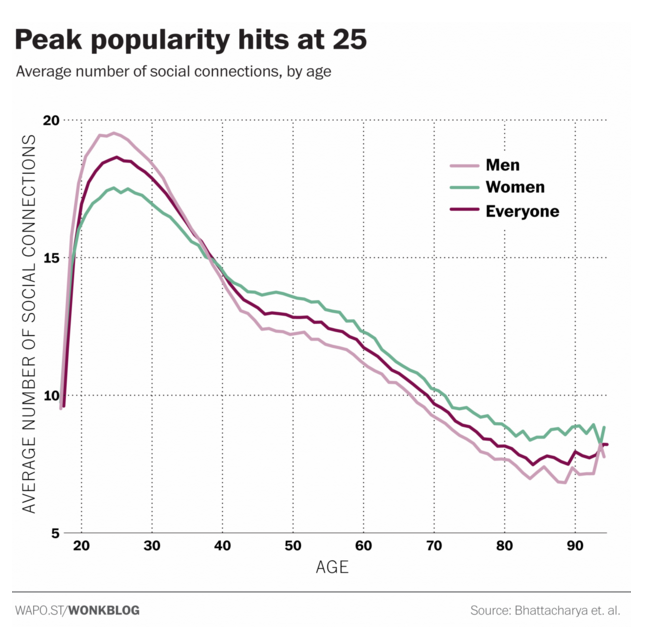The age when people are the most popular, according to science
Have you peaked already?

You're never more popular than you are at age 25.
Or at least, that's the age when we tend to have the most people in our real-life social networks, according to research recently published in the journal Royal Society Open Science.
Researchers analysed one full year's worth of cell phone call records for 3.2 million customers of a European telecom company. They found that the average number of people a person calls (or is called by) in a given month peaks around age 25. After that, your number of regular social connections nosedives until age 45 or so. Take a look.

"One important conclusion we can draw is that the average number of contacts is quite modest: in most cases, people focus their (phone-based) social effort each month on around 15 people," the researchers write. They note that this corresponds to the number of friends and family members people typically have face-to-face interactions with in a given month.
"Thus, we provide some evidence that the use of mobile phone technology does not change our social world," they write. "It also provides further indirect evidence for the fact that we use the phone to contact those who are emotionally closest to us rather than simply those who live furthest away."
Recent years have seen the rise of a hot-take industry dedicated to the notion that cell phones are making us less social or killing face-to-face interactions or otherwise radically altering our lives, usually for the worse. But this study doesn't find a whole lot of evidence for any of that.
When viewed through their cell phone records, peoples lives tend to follow a particular narrative arc: a period of "social promiscuity" and exploding social contacts in the late teens and early twenties, followed by a rapid narrowing of the social sphere from the late twenties through early middle age as people marry, have kids, and otherwise settle down.
But starting in the mid forties that decline plateaus a bit. "Because this age cohort is that in which ego's children typically marry and begin to reproduce in their turn, one likely explanation for this plateau is that it reflects the fact that parents are maintaining regular interaction with their adult children at a time when some of these might otherwise be lost," the study's authors write.
Interestingly, the researchers found that men tended to have more social contacts than women in their twenties. But around age 39 or so that dynamic flipped, and women had more social contacts for the remainder of their lives.
"The difference between the sexes seems to be primarily owing to the more frequent interactions by the females with their adult children and the children's spouses," the researchers posit. "Also, females probably interact with their own close family members (e.g. keeping grandparents updated on the children's activities) and the new in-laws created by their children's marital arrangements more than males do."
Of course, by only looking at cell phone call records this study is somewhat limited: text messages may show slightly different patterns of social interaction, for instance. And for a certain, probably not-insignificant number of people, phone calls are anathema. Those people may have very rich networks of social interaction either online or face-to-face that wouldn't be captured in data like this.
Still, the phone records provide a novel way to map the waxing and waning of the social sphere over the course of a typical person's life.
Copyright Washington Post
Join our commenting forum
Join thought-provoking conversations, follow other Independent readers and see their replies
Comments
Bookmark popover
Removed from bookmarks